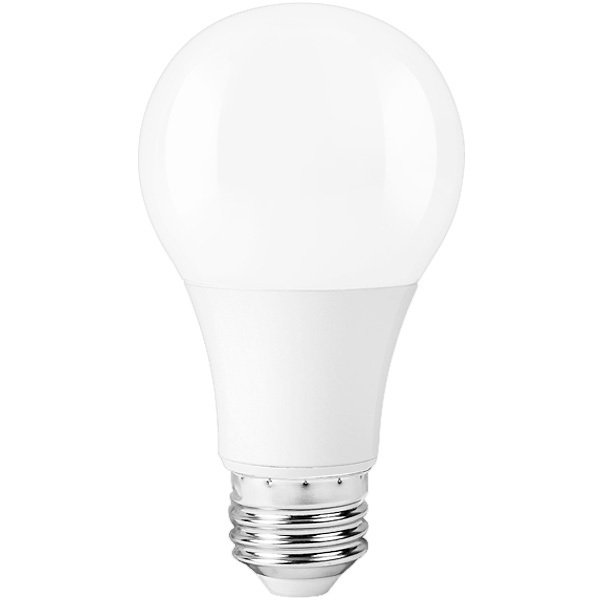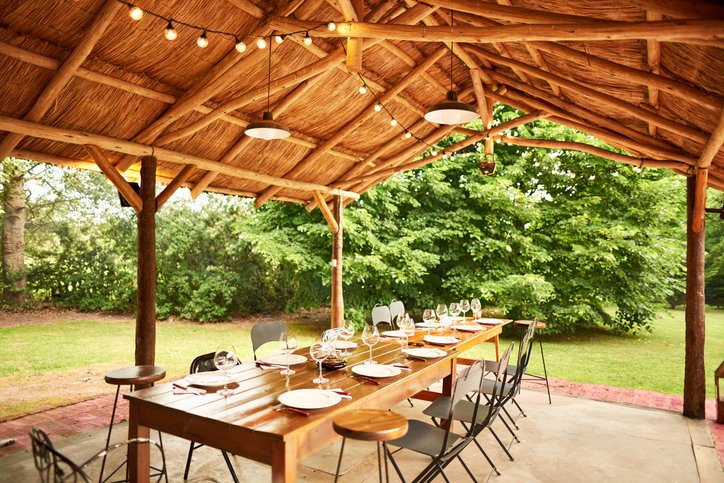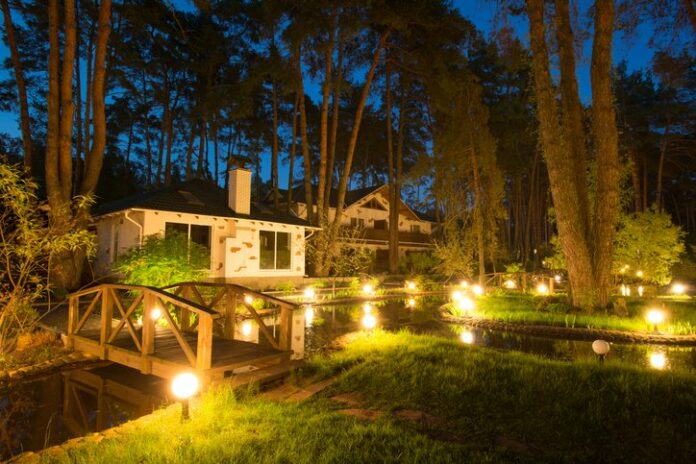Outdoor lighting at a residential home.
Outdoor lighting is an essential part of landscape design that is often overlooked. Thoughtfully designed outdoor lighting serves practical functions like illuminating pathways and entryways for safety and visibility. It also has aesthetic benefits like highlighting architectural features, adding drama, and extending the enjoyment of your outdoor space into the evening hours.
This guide will provide tips and inspiration to help you design beautiful, functional outdoor lighting for your home. We’ll discuss techniques to enhance curb appeal, safety, and ambiance weather resistance, wattage, and installation. Whether you’re looking to add subtle accents or make a bold lighting statement, you’ll find ideas to create the perfect lighting plan tailored to your home and needs.
Step 1: Assessing Your Needs
The first step to designing outdoor lighting is to consider how you want to use your space. What activities do you envision for your yard or patio? Entertaining friends and guests, dining al fresco, reading by the pool? Understanding your lifestyle needs will help guide your lighting plan.
Next, factor in safety and visibility. Outdoor lighting improves nighttime navigation, illuminates potential hazards, and deters intruders. Position pathway lighting and spotlights to maximize visibility and security.
Finally, determine your desired ambiance. Do you prefer a bright, vibrant mood or soft, subtle glow? Cool, contemporary styles or old-world charm? Your lighting design should complement your landscape aesthetics and architectural features. Think about how lighting can enhance the beauty of your outdoor environment.
FAQ: Does Ambiance Matter When Designing Outdoor Lighting?
Dramatic outdoor lighting used for a pool area.
Yes, ambiance does matter. Whether you are designing indoor or outdoor lighting, ambiance is key to how your spaces will look and feel. Light is a great tool for evoking certain moods or feelings. If you want a certain area to feel relaxing, then your lighting needs to reflect that. Here are some examples of how to light for different moods:
-
Cozy – For a cozy, welcoming feel, use warm white light bulbs (2700-3000K color temperature) in lanterns hung from trees or posts. Add uplighting on trees and focal points to create a soft glow. String lights also lend a cozy ambiance, so wrap them around seating areas, gazebos, or railings. Place luminaires with diffusers to emit a gentle radiance.
-
Dramatic – Make a bold statement and highlight architectural features with focused floodlights. Graze lighting placed at the base of structures casts intriguing shadows. Silhouette trees and plants with backlighting. Use color-changing lights on water features. Spotlights aimed at statuary or specimen plants lend drama.
-
Naturalistic – Showcase the beauty of your landscape with subtle, low-level lighting. Path lights on a dimmer allow you to adjust based on conditions and activities. Opt for small lanterns or bollard lights along walkways. Install step lights on stairs or decks for safety. Use moonlighting to mimic the soft glow of the moon filtering through trees.
Step 2: Choosing Light Sources
The next step is to choose the type of light source you want to use. This can impact the number of lights and fixtures used later on. Three of the most common light sources used for outdoor lighting are:
LED bulb
-
Incandescent – Incandescent bulbs produce light by heating a filament wire. They create a warm, inviting ambiance, but are not very energy efficient. Incandescent bulbs also have a shorter lifespan than LED or solar options.
-
LED – LED (light-emitting diode) bulbs are extremely energy efficient and long-lasting. The light they produce is bright and crisp. LEDs come in a range of color temperatures, from warm white to daylight. They work well for task lighting and accent lighting. Plus, their low energy use let’s you use more bulbs and fixtures on a single circuit.
-
Solar – Solar lights absorb sunlight during the day in order to power the lights at night. They are easy to install anywhere outdoors without wiring. Solar lights are more subtle, so they’re ideal for landscape path lighting. The initial cost is higher, but they have no electrical costs.
When deciding on light sources, consider the look you want to achieve, how much light is needed, and your budget. LED outdoor lighting strikes the best balance between efficiency, lifespan, and light quality for most outdoor spaces. But don’t rule out other options that could work well depending on your specific needs and design vision. Mixing multiple source types can provide visual interest.
FAQ: Should I Calculate Wattage and Lumens?
Yes, you should. Calculating wattage and lumens is key for ensuring your lights shine bright without causing chaos in your circuits. Think of it as finding the perfect balance between being able to see and having the breakers trip.
-
Wattage Wisdom – Wattage measures the power a bulb or fixture uses. It’s crucial to stay under 80% of your total circuit wattage to avoid overloading. Here’s a handy tip: for outdoor lighting, the calculation is a lot like figuring out max wattage for Christmas lights.
-
Lumen Logic – Lumens measure brightness, so the size of your space determines how many lumens you need. For example, a cozy 100-square-foot patio might need fewer overall lumens, while a sprawling 500-square-foot backyard could use more lumens. Other factors to think about include:
-
Coverage Area: Choose floodlights or omnidirectional bulbs based on how you want the light to spread.
-
Ambient Light: Consider existing light sources and adjust lumens for darker areas.
-
Location: Account for light blockage from trees or structures.
-
Activities: Ensure the lighting matches the task, whether it’s dining or strolling along a pathway.
-
FAQ: Should I Consider Sustainability?
When it comes to wattage, sustainability is a topic that can’t be ignored. Sustainable lighting means being energy efficient and environmentally friendly. It’s a trend that’s gaining importance in all areas of lighting. Not only does it help keep wattage low, but it also reduces energy costs. Here are a few ways to make your outdoor lighting more eco-friendly:
Electronic timer used for outdoor lighting.
-
Solar Lighting – As we mentioned earlier, solar-powered lights are a fantastic option for outdoor spaces. They’re easy to install, cost-effective, and rely on renewable energy to illuminate your outdoor space. The best part? No electrical wires or electricity needed! They’re perfect for areas where wiring is impractical, and they can also be used as accent lighting when needed.
-
Timers – Timers are your secret weapon in controlling when your outdoor lights turn on and off. No more lights left on accidentally or staying on longer than necessary! With timers, you can reduce energy waste and lower your electricity bill. Look for programmable timers that let you customize the lighting schedule to match your needs and lifestyle.
-
Motion Sensors – Motion sensor lights are triggered by movement and automatically switch off after a period of inactivity. That means lights are only on when they’re actually needed. Motion sensors are not only great for conserving energy, but they can also help deter crime when used as security lights. Strategically place them in areas like driveways, walkways, and entryways for a bright welcome when you arrive and added peace of mind.
Step 3: Determining Locations
Now that you know what type of lighting you are using, it’s time to decide where you are going to place them. Placement is key for both function and ambiance. Consider the main areas where you want light in your yard or patio. The three most common locations are:
Outdoor wall sconces used at entryway.
-
Entryways – All entryways should be lit. This will increase curb appeal while providing safety and visibility. Lanterns on either side of the front door can create a welcoming glow. If you have a covered entry way, a ceiling light can be a nice, bight addition that ensures you can clearly see. Step lights are perfect additions to stairs. Landscape bullets can also be used to highlight walkways and architecture.
Solar path lights used along a walkway
-
Paths – Lighting pathways and walkways is a quick and easy way to boost curb appeal. They also help mark a clear route and prevent tripping hazards. Use pathway and garden lights to line driveways, walkways, and even flower beds. For more modern look, embed low-voltage lighting the ground. Lights should be spaced close together for higher visibility. And make sure to extend the lighting along any steps or changes in elevation.
Patio lights and decorative pendants used with outdoor seating.
-
Seating Areas – If you are lighting a patio, the seating area is the most important part to illuminate. Lights should shine directly onto patio and deck seating spaces. Use floodlights on eaves or trees to cast light downward. Install sconces or post-mounted fixtures to directly illuminate gathering areas. This will make these spaces functional after dark.
Step 4: Selecting Fixtures
The next step is the fun part, selecting fixtures. There are a wide variety of outdoor fixture options that can be both functional and decorative. Here are a few of the most common.
Wall Mount Fixtures
Wall lantern from Euri Lighting
Wall mounted fixtures are a popular choice for lighting up gardens, patios, walkways, and entryways. They provide both ambient and task lighting while blending into the architecture. Look for fixtures made of durable materials like metal or high-grade plastic that are weather and rust resistant. Opt for a simple design like a sconce, or pick something more ornate like a carriage lamp. Position wall mounts to illuminate steps and pathways.
Spotlights
Use spotlights to highlight architectural elements, landscape features, or areas used for entertaining. Spotlights come in a range of beam spreads, from narrow spot beams for accenting specific details to wide flood beams to illuminate a larger area. Consider spotlights with adjustable heads to aim the light where needed. Fixtures rated for outdoor use will be weatherproof. Ground stakes or wall mounts allow flexible positioning.
Patio string lights suspended over an outdoor table.
Patio String Lights
Patio string lights are some of the most popular outdoor lights used for patios, backyards, and commercial spaces. Available in a variety of lengths, finishes, and socket types, they can be quickly suspended from posts, trees, and more. We recommend looking for patio lights that are designed for permanent outdoor use, like our commercial-grade strings from PLT. To see how our patio stringers compare to those from other brands, check out our Ultimate Patio Light String Showdown series on our blog.
Holiday String Lights
Holiday string lights add a magical, festive touch to any outdoor space and can be used all year long. They come in warm white or multicolored for plenty of design options. Use them to outline spaces, wrap around columns or railings, or create overhead canopies. Look for outdoor-rated string light sets that are UL-listed with weather resistant bulbs and durable cords. Ensure the lights are spaced closely enough to provide sufficient illumination. Use clips or hooks to neatly install them.
Other Popular Options
There are lots of other popular outdoor lighting options too. You might consider using some of the following:
-
Rope Light
-
Post Cap Lights
-
Tape Light
-
Decorative Solar Lights
-
Pool or Fountain Lights
-
In-ground Well Lights
Step 5: Putting It All Together
You’ve made it to the final step of your outdoor lighting journey! With a general lighting plan in mind, an understanding of the types of lighting you’re using, and carefully selected fixtures, it’s time to bring your vision to life.
FAQ: How Do I Ensure My Outdoor Lighting is Safe?
Safety is always a priority, no matter what you’re installing. When it comes to outdoor lighting, a few extra precautions are necessary to protect the wiring and fixtures from the elements. Here are some key considerations to keep in mind:
Receptacle over used for outdoor lighting.
-
Weatherproof – Make sure all electrical connections are weatherproof and designed for outdoor use. Look for fixtures and wiring rated for wet locations. Seal any holes in exterior walls after running wires to prevent moisture intrusion.
-
Outdoor outlets can also be protected with weatherproof covers.
-
Cord protectors can be used to protect string light connections.
-
-
GFCI Circuits and Outlets – Outdoor lighting should be on a GFCI (ground fault circuit interrupter) protected circuit for safety. This will shut off power if a short circuit occurs. Consult an electrician if needed to ensure proper setup.
-
Heights – Position lighting high enough to avoid causing glare or being obscured by plants/objects, but not so high as to create dark shadows. For pathway lighting, install fixtures at consistent heights of 5-7 feet. For wall sconces or floodlights, 7-9 feet is ideal. Be sure to follow all local building codes.
-
Secure Mounting – Use the manufacturer’s specified mounting hardware and make sure lighting is firmly fixed in place. This prevents fixtures from detaching in high winds. You should also caulk around mounts to help limit water penetration.
-
Timers/Photocells – Using timers or photocells ensures lights turn on only when needed, saving energy. Make sure any exterior switches are also rated for wet locations.
-
Guy wires – Guy wires are an absolute must for patio light strings, especially for long runs covering long distances. They help keep the strings from sagging and also keep them from getting blowing around by the wind.
-
Professional Help – If you’ve never installed wiring, are unsure about installation instructions, or complicated wiring is required, we strongly recommend consulting a qualified electrician or landscape lighting company. They can ensure proper installation and code compliance.
Examples to Get You Started
Are you ready to transform your outdoor space into a haven of light and charm? We’ve got just the inspiration you need! Here are a few examples to kick-start your imagination and get those creative juices flowing:
Outdoor lanterns illuminating an entryway.
Warm and Welcoming Porch
This cozy front porch uses sconces to create a welcoming glow. The sconces flank the front door, highlighting the entrance and bringing out the warmth of the wood. This makes this porch feel like home.
Outdoor path lights used to prevent tripping.
Driveway with Path Lights
Path lights along this driveway and walkway provide visibility and safety. Small path lights are placed along the edges, lighting up the route from the street to the front door. This makes coming home at night easier and safer. The path lights also add subtle decoration.
Outdoor lighting used in a garden.
Backyard Ambiance
This garden seating area uses Christmas lights in trees and other greenery to create a magical ambiance. The lights provide a warm glow for evening entertaining, transforming this section of the backyard into an inviting oasis.
These examples are just a taste of what’s possible for your outdoor lighting. So go ahead, let your creativity shine and turn your space into a sanctuary of light and wonder!
No sure which outdoor lighting fixtures are best for your application? Our lighting experts are here to help. Call 1-800-624-4488 to speak with one of our US-based lighting experts. They can help you find the perfect lights and fixtures for all of your outdoor spaces. You can also browse our wide selection of outdoor lighting by visiting our website, 1000Bulbs.com.
blog.1000bulbs.com










